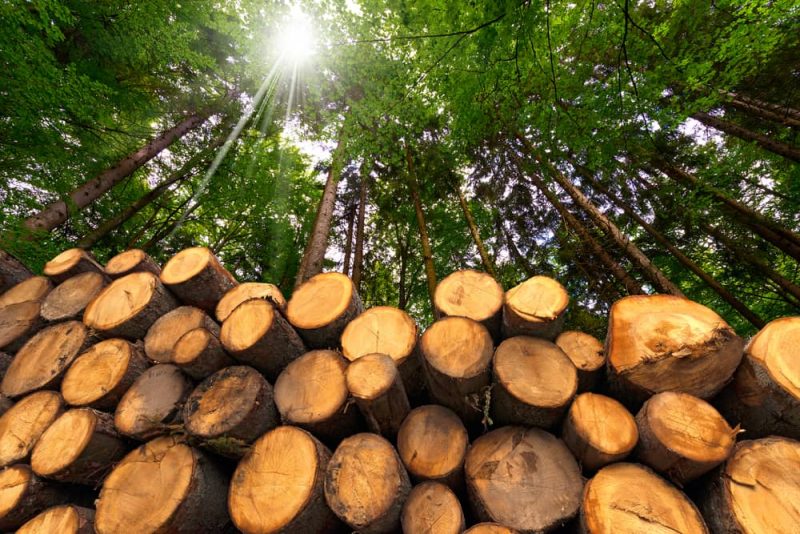The biomassIn ecology, it refers to the total amount of living matter contained in an individual, a rung of a food chain, a population or even an ecosystem, expressed in weight per unit of volume.
On the other hand, biomass is also the organic matter that is generated through a biological process, either spontaneous or caused, and that has the necessary properties to become a source of combustible energy. We could call this last meaning the “Useful biomass”, since his area of interest is specific to obtaining biofuels (agricultural fuels). For instance: firewood, food scraps, livestock waste.
This term has become more relevant since the rise of biofuels, necessary as an alternative to fossil fuels and its fluctuating market. However, the “organic matter” required for biomass is often confused with living matter, that is, with which it integrates living beings such as trees (despite the fact that much of the bark that supports them may be, effectively, dead).
It is also a mistake to use the term biomass as a synonym for the potential energy that said organic matter contains, more than anything because the relationship between the amount of usable organic matter and the energy that can be obtained from it is variable and depends on many factors.
The “useful” biomass

Biomass serves to get power. To do this, it is based on taking advantage of the decomposition processes of organic matter under controlled environmental conditions, in order to obtain hydrocarbon mixtures of energy potential, especially when feeding internal combustion engines, such as those of a car.
We can identify three types of useful biomass:
- Natural biomass. The one produced without any intervention of man, such as the fall of the leaves in a forest.
- Residual biomass. It is the residue or by-product of other economic activities, such as agriculture, livestock, forestry or the food industry, or even the recycling of oils.
- Energy crops. Whole crops destined to obtain biofuels, focused on some type of vegetable or fruit tree whose energy power is high.
Advantages and disadvantages of biomass
The use of biomass as fuel has positive and negative aspects:
- It is less polluting. Compared to oil and its derivatives, or coal, biofuels generate low amounts of CO2 and less environmental damage, although this does not mean that they are really green fuels.
- Take advantage of residual matter. Much of the material that normally goes to waste or decomposes uselessly, has a certain energy value if it is used as a feedstock for biofuels. That also makes these relatively inexpensive and easy to obtain.
- Not as effective as other fuels. Compared to fossil fuels, their performance is insufficient to be, for the moment, an efficient alternative in the face of world energy demand.
- It poses ethical dilemmas. More than anything in relation to the diversion of food (corn, fruits, grains and cereals) from the food industry to the energy industry, which is more important to obtain fuel than to feed the hungry population.
Examples of useful biomass

- Firewood. A classic example of the use of organic matter is the collection of firewood to burn and thus obtain heat, both to heat a home through chimneys, and to feed a fire in which food is cooked. This method dates from time immemorial and still persists among human customs.
- Nut and seed shells. These residues from the ingestion of food products are commonly discarded in the garbage, but they have a non-negligible combustible value. In many rural homes it is stored and used to fuel fires, or even in obtaining vegetable oils for lubricant.
- Leftovers. The organic matter left over from our meals has a relative energy potential, not only as food for compost processes and soil fertilization, but also in obtaining biogas through anaerobic digestion processes (without the presence of oxygen). The bacteria that lead this process produce high levels of methane, similar to what happens in our intestines, which makes biogas highly flammable.
- Beets, cane, corn. Fruits rich in sugars, such as cane, beet, corn, are usable in obtaining bioethanol, through a fermentation process similar to that of obtaining liquors, since it produces a hydrated alcohol. 5% of the water is removed from said alcohol and an energetically usable fuel is obtained, similar to gasoline.
- Stems, pruning residues, wood and other greens. In the body of plants, sugars such as cellulose, starches and other carbohydrates resulting from photosynthesis are stored, which are usable as biomass in processes of conversion into fermentable sugars to obtain biofuels. Many of these residues are collectible without sacrificing food, since many plants must be pruned, replanted or uprooted after bearing fruit and this material is usually discarded.
- Corn, wheat, sorghum, barley, and other grains. Similar to obtaining beer, these cereals and vegetables are extremely rich in starches, which are complex carbohydrates from which bioethanol can be obtained through alcoholic fermentation.
- Sawdust or sawdust. One possible source of biomass is found in the huge amounts of powdered wood disposed of by sawmills and the timber industry as such. All this dust has the same fuel potential as wood, as well as being a source of cellulose for obtaining fermentable sugars in bioalcohols.
- Wine must and sulphured wines. Decomposed wines and must residues from their manufacture are sources of biomass, since they provide raw alcohols from which the sulfur dioxide (SO2), their methanol load (corrosive to combustion engines) and finally they can be used to obtain bioethanol.
- Livestock waste. Livestock is an important source of organic matter that can serve as biomass, such as ruminant excreta (whose exclusive diet of vegetable cellulose is promising) or even the fat left over from animal use.
- Household residual oils. A source of liquid biomass is the oils that we discard after cooking, mostly made from sunflower, canola, even olive, in short, vegetable products. The production of biodiesel from them requires filtering of solid waste, transesterification steps to convert triglycerides into methyl esters, and the addition of methanol. After neutralizing the pH of the result, biodiesel and glycerol are obtained. The latter is withdrawn and is usable for the soap industry, while biodiesel is purified and used as fuel.
